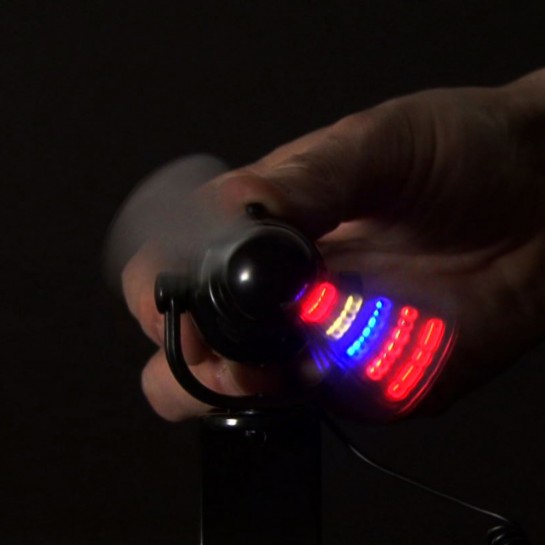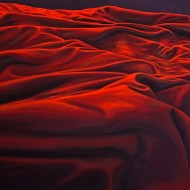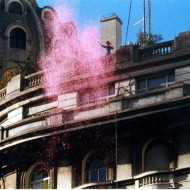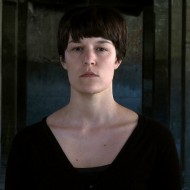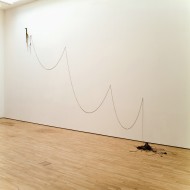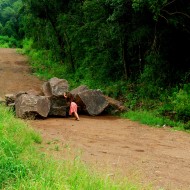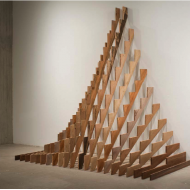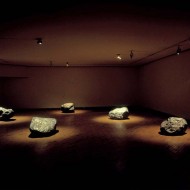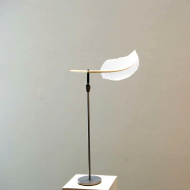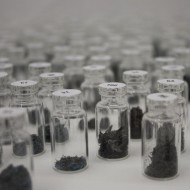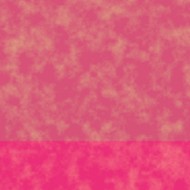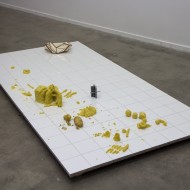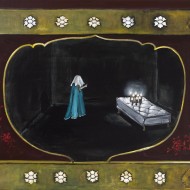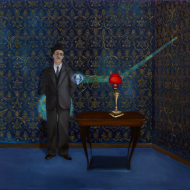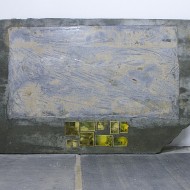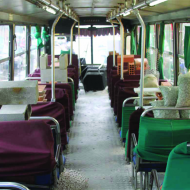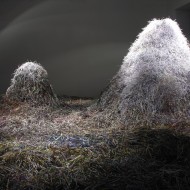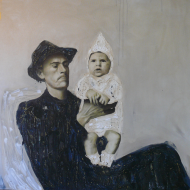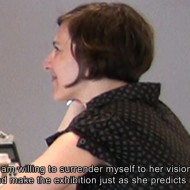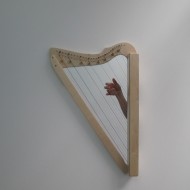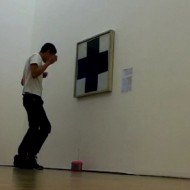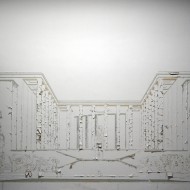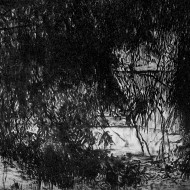- Choice 20
Work
Cuculí
Artist
Daniel Jacoby
By
Jesse
McKee—
more +Cuculí, an energetic but enjoyably paced video by Daniel Jacoby, takes you on a trip to Japan. The narration performed by Jacoby details quick snippets of information. The artist recounts the slippery details that stop you in moments of pause when you encounter them while travelling. He points at the insignificant glimpses of the every day that catch you and remind you that you are away from where you live. The threads hanging from neon lights and emergency exit signs in the metro system or the memorable stories from the man that sits next to you on an airplane. These quick winding moments build anticipation by provide little comfort in their conclusion. Punctuated with melodic and dissonant intermissions, the tone in the story changes to rough frequencies overplayed with instructional language from a woman’s voice about the geography, names and sounds of birds.
The images are shot in studio and are rich and slick in terms of result, even though an economy of means seems to be hand in their making. Including shots of reflectively lit surfaces, an LED pocket fan, CGI renderings of abstract forms which resemble wrapped topographies, and a trinket drinking bird, with the timing of a veteran performer, plunging every so slightly to the rhythm of a dramatic stringed serenade.
-
Choice 19
Untitled – Series : Paisajes
Juan Manuel
Rodríguez ArnabalBy
Andrew
Berardini—
more +It all ends in sex or death, usually.
Both even.
I think I’ve been writing about shadows on bedroom walls and tangled sheets all of my life.
These will, with some likelihood, be my last thoughts as well. The sheets: the crisp unloving whites of a hospital bed, the shadows: dancing on the bloodless eggshell of a nursing home or an intensive care ward.
But there have been other sheets and other walls. I think it comes from the stillness of a wakefulness that occurs whilst laying in bed. If you immediately roll out, bare feet scraping on hardwood to the bathroom, the normal course, you miss this calm, the still point in a turning world. Perhaps it is a wholly unnecessary stillness, brought on by sloth or indolence, but its quietude is indelible. The sheets wrap your limbs, the play of light and shadows, a hint of what the world has to offer, Plato’s perpetual tease.
I linger in bed because I’m too sick to get out or of the body lying next to mine.
-
Choice 18
Acción / Intimidad Publica
Juliana
IriartBy
Isabelle
Le Normand—
more +Colourful explosions, dazzling energy, lyrical movement pervaded by a force absorbing all gravity, a random harmony, and a calm dispersion – there is nothing new about that, belonging to a language borrowed from abstract expressionism. However Intimidad publica by Juliana Iriart presents the world as a canvas, and the colours do not dissolve indelibly on a surface, but in our memories, our feelings and within ourselves. Very straightforward instructions: squares cut out of coloured paper are thrown from the top of a building, recreating the magical of a firework. The role of the ‘heroic’ artist may held here by anyone, generally a friend, a friend of a friend or a small group that deploys the colours at sunset.
The art originates as a social event. First of all group energy is generated and then freed. It all starts off with smiling faces, as even before the image is produced, people are gathered side by side: watching the street down below; awaiting the signal; their hands fumbling with the paper; arms half immersed in the bags bursting with colour; childish immersion in the materials, where art is more of a sensation than an idea. In the street below, some people realise that something is going to happen, and primitive curiosity glues them to the spot, eyes expectantly raised. Meanwhile others, several minutes before the event, are oblivious to the fact that a surprise is shortly forthcoming, their feet leading them exactly within range of Intimidad publica, and those who had not anticipated seeing any art that evening, will discover that it is more the art which will embrace them with open arms.
-
Choice 17
A-PHAN-OUSIA
Maya
WatanabeBy
Anca
Rujoiu—
more +A conversation with Maya
What about A-phan-ousia? Is it an invented concept? Yes, a-phan-ousia is an invented Greek word. It means: a – prefix negative: don’t, without. pha (n) – talk (to appear, show) ousia – essence, substance. pha means talk and phan means to appear, to show. Juxtaposed ideas produce a third one (as Eisenstein montage or the Japanese ideograms) and keep open the meanings, I mean, they don’t define or determine a close meaning. There is one poem on the London underground that always drew my attention, I don’t know in which station is displayed, but it goes like this: Stations – As he travels home on the Northern Line he is reviewing his marriage. When he used to tell her that he loved her it was certainly true; but now the words -though they still fulfill a useful and ceremonial purpose – have lost some of their resonance as in Barons Court or St John’s Wood or the beautiful Shepherd’s Bush. (Connie Bensley). It is a reminder that any expression of feelings can turn as banal as naming a popular tube station. How can words become suddenly devoid of emotional content and lose their resonance?
-
Choice 16
Wing Beats
Ricardo
BreyBy
Jesse
McKee—
more +Wing Beats (2006) is a sculpture by Ricardo Brey, indicative of the artist’s resourceful use of space and his sensitive use of materials, which conjure allusions between the cultural sphere and the natural world. Several strands of golden chain are piled on the floor and draped along the wall, rising up in large bounds to a taxidermied bird head that is fixed to a high point, beak facing out. This ethereal animistic assemblage was made at the same time as Brey’s encyclopedic work Universe (2006), a collection of over 1000 works on paper that associatively documents and elaborates on the natural world. In this landmark work, renderings of flora, fauna and minerals, sit alongside allusions to natural and even extra terrestrial forces such as the moon’s orbit.
Grounded in a literary impression, Wing Beats speaks of an 18th century text by Anton Josef Kirchweger, in which the Aurea Catena is decoded. This metaphor of Homer’s golden chain, serves as an alchemical guide to the cyclical relationship between heaven and earth. In this text, one of the principals that are put forth is that those who are the animate makers of the world must posses a sound understanding of the spiritual and scientific forces of nature. Without this knowledge, it is said the maker’s product can appear fruitless and unworthy. The ways of knowing that are contained within the successive platforms of understanding of the Aurea Catena are accessible to its followers once they solidly comprehend each initial level in their entirety. At this point the path to the next link in the trajectory become visible and accessible.
-
Choice 14
Límite
Cintia Clara
RomeroBy
Andrew
Berardini—
more +Setting: A girl. A road. A jungle, very green. Some stones, big ones. Daytime.
She is blocking the road.
She is putting the finishing touch in place.
She is unblocking the road.
She is fighting a good fight.
She is finishing her monument.
She is taking a little stretch.
She is ready to pounce.
She is showing just a little leg.
She is letting her hair blow down.
She is marking this as her all-time favorite dirt road.
She is completely unaffected by the road, it is not in the least special .
She is putting her hands where we can see them.
She is refusing to show her face.
She is acknowledging her weakness.
She is assured in her strength.
-
Choice 15 bis
Progresión
Juan Fernando Herrán
By
Isabelle
Le Normand—
more +Progresión is as a light and airy sculpture, made of wooden battens. The artist plays with the modularity and the rhythm of the wood. The work is similar to another series where the artist shows a lot of of irregular stairs (“Escalas”) which the people of Medellin use everyday. These stairs, with a sculptural form, function as the abstract for the wooden sculpture and creates a symbol of progress and effort, transcendence and the idea of surpassing oneself.
-
Choice 15
Terra Incognita
Juan Fernando
HerránBy
Isabelle
Le Normand—
more +Five rocks imbued with light.
Terra Incognita consists of a mundane group of lead boulders.Lacking in any human, emotional or sentimental context, the stones stand like strange sculptures forming an abstract installation.
The rocks are lost in the environment but are awarded a new self-worth here, in their own right. The opportunity is presented to examine and scrutinize them, as if partaking in the rock’s dream and the desire to exist for a wider audience somewhere in the world.
Rocks, fundamental elements of the Earth and humanity, are like relics of a larger whole and remind us of the fear of going beyond ourselves. They symbolise a divine mystery, the presence of matter all around us. Individually.
However, the rocks simultaneously appear to be something alien, objects from another planet, disclosing another side to human beings: the deviation, distance and alienation from the fragments. We wish to bridge this gap and to communicate with people externally. My reaction is somewhere between these emotional reactions, gently swinging from one to the other, like a hammock.
These rocks are solidly built and accessible, not spectacular, appearing more like a person which enables us to empathise.
-
Choice 13
On the direction of the wind
Manuela
RibadeneiraBy
Anca
Rujoiu—
more +The symbolism of wind covers an amalgam of experiences, events and beliefs. It can almost describe anything: from ways of thinking and acting to feelings and politics. The wind can be soft and tender: gently blowing on her skin, it reminded her the pleasurable feeling of not knowing where she was going. The wind can be too big to handle, yet to powerful to escape. You are like the wind, she was told. Strong and free. You can’t cage the wind, can you? Winds are blowing when we least expect them, but they can bring you to a more interesting place than you could have planned. The wind was like a breath from another world. She felt it sweep along her skin. When she woke up the image in her dream vanished like the smoke before the wind. She was tired of speaking, everything she was saying was blown away by the wind the moment she uttered a word. The words were falling onto each other on the page, crossing each other, blending, merging together as if the writer didn’t have any plan in his mind in the act of writing, as if the words were carried on by the wind. On which direction was the wind going?
-
Choice 12
Sans titre (figurants)
Estefanía
Peñafiel LoaizaBy
Andrew
Berardini—
more +This is an antidote. This is a poison. Both the build up and the break-down. This is all the words ever spoken and all the words ever removed. When we speak it would be powerful and dangerous if objects absorbed our voices, the things that we say. The pillow you whisper into while you sleep could be stolen by enemies. Our telephones might become radioactive with language. Would Gandhi’s mouthpiece exude the inspiring equanimity of the man? Would a banker’s echo with imperious greed? The servant’s with servility (or perhaps secret revolution)?
Death might hollow out the trunk, but the tree can live on. Erasure is closer to the end than death, but even erasure leaves a lacuna, a stain, not even Rauschenberg could fully disappear a de Kooning. Disappearances leave traces. This is the end of all stories, of all lives, these traces. The word “disappearance” has absorbed the emotions of its speakers, the actions they utter. I can’t say the word without a host of lost souls and political casualties whispering in its shadows. Their specters hiss at the end of the first syllable and leave behind a wet stain in roll of the last.
Things can be altered even by words. Even words are things. Ink and graphite has not such memory, but in the space where there is presence, there is absence. The eraser bears the sin of the erasure. They have memory of a different kind.
Estefanía Peñafiel Loaizahas saved in this small jars the corpses of used up erasers, soaked with disappearance, marked but mute, arranged like specimens or spices.
-
Choice 11
Plan
Tamara
KuselmanBy
Jesse
McKee—
more +“This is a only a test” – is the first declaration in Tamara Kuselman’s hypnotic video Plan. At first, the tone sets the audience in a state of reassurance, while at the same time washing the screen with alarming colours; deep red, cold yellow and bright orange. The effect recalls those moments of rehearsal and protocol that many children of the cold war era experienced when interludes of public alarm testing interrupted our warm attachment to the household television and its programming. It is this youthful place of confusion, assurance and discomfort that is manipulated in a very affective way by Kuselman in this bold video.
The washes of solid colours disintegrate into strange zig zags, grids and obtuse delineations of space – now appearing in tinted versions of the introductory washes—purples, peaches, pale greens and brown—form digitally flat but psychedelic renderings of the screen space. Thin grey bars appear and stretch horizontally across the screen filling it vertically. Is this signal loss in the image a further threat from the uncontrollable outside forces? The colour fields and abstractions in the film pulsate with energy and movement, evoking the history of structural moving image artists such as Paul Sharits and his flicker films.
The narration performed by the artist herself, shifts in positioning from official language to a point of view perspective of an ambiguous disaster. ‘Probably there would also be smoke’, “A woman would try to open a door by banging it”, “some glass pains would be broke” and “children have their hands over their heads”. These distressing statements are delivered in a deadpan tone and overlaid with other vocalized sounds representative of
-
Choice 10
A Mount-Rushmore-Resembling Piece of Cheddar Cheese Melted to a Perfectly Flat Squared Slice
Daniel
JacobyBy
Anca
Rujoiu—
more +An imagined wandering through an exhibition I have only seen in pictures:
1646, The Hague
DJ accepted the invitation from an artist-run space to have a solo exhibition. He had some clear ideas on how his next exhibition could take shape even before this invitation came. There were works scattered in his studio that always seemed to belong together; the context of an exhibition could potentially strengthen or question these connections. There were also a few ideas that had been haunting him for a while, ideas well articulated in conversations, but never materialized into a physical form. He thought a lot about versatile objects and products in terms of sculptural material. Such as potatoes and towels…There are so many things you can do with towels, DJ was thinking – lie on them, dry, cover or clean things, reserve seats, stop noxious gases from entering through the gap beneath a door, hold hot objects. Whereas potatoes- there are as many varieties as many uses and shapes on a global scale. What was at stake was not so much to explore new uses of an everyday object we are very familiar with, but to highlight the malleability of objects and their ability to undergo a process of transformation and manipulation that imbue them with new meanings.
How-To Take the Way Around the Workaround
DJ was thinking of a tutorial he did some time ago on 3D modeling software in which he showed the process of creating a cube following the technique of an origami with a square plane that gets folded as if it was a piece of paper. The video showed at the end that the resulting cube was exactly the same that could have been obtained through the simple click of the ‘Add cube’ command. The cube is identical irrespective of how it is created, but watching the modeling process invites the viewer to envisage the sculptural potentiality of one of the most basic geometrical shapes.
-
Choice 9bis
O louco
Flávia Metzler
By
Isabelle
Le Normand—
more +Flavia Metzler toys with our expectations and deliberately creates a Surrealist painting 80 years on. Her work is constructed from images generated from the past, like someone who speaks beautifully with chosen quotes. It is a delicate balance. She trusts hers intuition and boldly forges ahead by using the past like a child, surprise blending with fear.
-
Choice 9
And Everything Had Beautiful Sense That Never Was and Ever More
Flavia
MetzlerBy
Isabelle
Le Normand—
more +And Everything Had Beautiful Sense That Never Was and Ever More by Flavia Metzler does not shy from being magnificent.
The artist uses a combination of methods to entice the spectator, including, but not confined to: shades of blue; a 19th century intricate and decadent pattern; a mysterious light which enters through a wall, passing through a red lamp and ending in the crystal. The light, which passes through the red lamp in the form of a heart, seems to be filled with mystical connotations; a sky blue halo behind the man in a suit resembles angel wings, all the more so as the arms are not visible. The long title, which penetrates the whole image with its own invisible and absurd light, but filled with good intentions, is like the global and harmonious flight of the hummingbird, full of humour, an absurd composition of these different elements: the unexpected expression on the man’s face, which appears a little distressed, like an innocent gangster from a New Wave French film;
-
Choice 8 Bis
First Agreement
Matheus Rocha Pitta
By
Jesse
McKee—
more +The work chosen from arte-sur.org by Matheus Rocha Pitta, Circular (2011), did not lend itself to a presentation at the Palais de Tokyo due to its site-specific context in Rio de Janeiro. In the place of Circular, Rocha Pitta proposed and realised the production of a new work, Fist Agreement (2013).
Initiated by the remembrance of a quote from the artist Thomas Hirschorn, “To change reality you must first accept it. Agreeing with reality is the first step to changing it”, the artist Rocha Pitta associated this thinking with his research into funerary slabs from ancient Egyptian, Greek and Roman culture. In these artifacts, the dead are continually depicted, in painting or relief sculpture, shaking hands or embracing the divine.
With his work First Agreement, Rocha Pitta leans two rectangular concrete slabs against the wall. Embedded within the surface of the material are images clipped from the pages of newspapers and weekly magazines, showing a series of greetings and agreements between politicians and military figures. Mirroring the poses of the funerary slabs, the figures hold hands, hug and place kisses on each other. These scenes are real events, but also staged encounters for the press. These public displays of warmth, welcoming and indeed agreement are transmitted as signs to the public that partisan alignment and cooperation is at hand in their governmental and military processes.
-
Choice 8
Circular
Matheus
Rocha PittaBy
Jesse
McKee—
more +Matheus Rocha Pitta’s sculpture Circular is placed within the every day affairs of the Flavela de Maré in Rio di Janeiro. Commissioned for the inaugural set of projects by the contemporary art agency Traversias, the institution asks artists to consider the situation of this Favela as a site of exhibition and action—attempting to bridge the barriers between contemporary art and the economically disadvantaged community of the neighbourhood.
A run down bus is parked along the side of a road. Inside, the artist has created a series of sculptures; assembling, piling and pouring construction materials such as brick, gravel, terra cotta roofing tiles and concrete blocks, on the seats of the bus. This eerie and still configuration of volumes alludes to the presence of the every person. This is relatable to the white plaster and bandaged figures of the American artist George Segal, who used the term ‘pedestrian space’ to describe the overshadowing of real life and sculpture.
Stayed, rough and cheap, the choice of materials by Rocha Pitta speaks to the architectural surroundings of the Favela de Maré. Formally this choice also references the history of arte povera. Within this late 20th century movement, artists such as Kounellis, Penone, Pistoletto and Zorio were revolutionaries in using everyday materials to speak of their political, cultural and social concerns of the post-war period in Europe. In this lineage, Rocha Pitta continues to create a bold and direct relationship between the viewer, artwork and author, when they uses everyday materials for practice. This choice is especially poignant within the context of Rio di Janeiro, as it is clearly reactionary to the major growth of material wealth within the city in the past decade.
-
Choice 7
Más trabajo heróico (More Heroic Work)
Eugenia
CalvoBy
Andrew
Berardini—
more +It’s really quite sad, but words have failed Eugenia Calvo. Maybe I only think its sad because I’m a writer, and maybe only sad at first. Later it bursts with beauty like when it rains indoors from ceiling sprinklers during a fire.
Words are only tools after all. Sometimes they just don’t work. I don’t own many tools, so I’m often tasked on how to fix my clogged sink with only a red rubber mallet or to repair a broken doorknob with a needle and lavender thread. These are obviously not the right tools, but I try to manage with what I have.
Not Eugenia.
The words started to fail a little bit here and there, an inappropriate synonym, a untranslateable idea, a cliched and tinny phrase. This happens often I think, but for most people it’s merely a blind spot. You really have to look very closely to notice a blind spot, and mostly we just use the wrong word, the rough translation. Certain languages just don’t have a word for the color blue. When asked about blue, it’s not like the speakers of these languages don’t see blue, but they find it easier not to see it. It’s difficult to see things you just don’t have the words for.
Eugenia read the logistician Wittgenstein: “What cannot be spoken about, we must pass over in silence,” but then promptly ignored him. Language foundered and she moved on, as in a crisis, provisional objects filling in for the failure of words. It might have begun on plates during dinner. She would arrange her food just so. The pictures on the plates were very helpful in this regard, one wonder if her family had just regular white plates if Eugenia’s innovations in linguistics would have happened at all.
-
Choice 6
Cycles of Life
Sofía
RuizBy
Isabelle
Le Normand—
more +Cycles of Life is the powerful fusion of an autobiographical and contemporary portrait of a child imbued with end of 19th century sensitivity evoking family cycles and cycles in art. A lack of detailed hands or faces results in an abstract painting, the father figure in particular resembling a painting from the middle of the 20th century. The portrait by James McNeill Whistler of Miss Amy Thomas Brandon, for example, is almost completely abstract, except for the delicate drawing of the baby’s facial features, a style which particularly suits babies and children who are still in the making, developing an identity. Life cycles also surrounds the child with an abstract vocabulary, but instead chooses to make the face of the child and the father photographically accurate. We find ourselves here in different territory, historically we can talk of Freud or of DNA, and personally as the artist pointed out the lack of photographs from her childhood spent with a mother suffering from memory loss. Indeed, the absence of a mother here is striking. We question what this baby is doing, and the only response that we have is the artist herself. Assuming that the baby is Sofia’s, the artist was obliged to develop the next generation in order to create her history of the latest, with herself as a baby, and her father as a young man.
-
Choice 5
Un Futuro Certero (A Certain Future)
Tamara
KuselmanBy
Anca
Rujoiu—
more +Chance is central to most of our own lives and their winding turns. The unforeseen affects us by asking us to alter course and to adapt in relation to it.[1] As an artistic strategy, chance indicates a refusal to take an authorial position and a reinforcement of the contingent aspects in artistic production. The use of chance underlines that artistic production, its reception and meanings are never completely isolated, but subject to external decisions and interventions.
When invited to put forward a proposal for a solo show at L’Espai Dos de la Sala Muncunill in Spain (2011), Tamara Kuselman decides to suspend her personal responsibility and to surrender her practice to a fortune-teller that is supposed to formulate the content of the exhibition. The common pressure of delivering a proposal long time in advance is seemingly loosened up by the confidence in the miraculous effects of chance and unforeseen consequences of risk-taking. But is there any direction of freedom when working under instructions? Is it a relief to be told what to do or a suffocating constraint? How far can one embrace risks?
Kuselman plays out and undermines the myth of the artist taking risks and letting things to get out of her control. Yves Klein’s photomontage “jumping into the void” is a direct reference. The exhibition becomes an
-
Choice 4
Comunitas (Wall / Harp)
Guillermo E.
Rodriguez RiveraBy
Jesse
McKee—
more +When you approach the intruding precarious wall of Comunitas (Wall/Harp) you become aware of its temporariness, built and designed with functionally as its DNA . This prosthetic structure contains within its liminal space, a small harp is snugly secured in a cut out, acting as a transitory border between either sides of the wall. The architecture of the arrangement prohibits willing players to cradle the harp into their body, denying them the ability to place both hands on either side of the strings. Here Guillerme E. Rodriguez Rivera stages a rather cruel trick on the visitor. The dumbness of this pre-empted relationship, existing between the anticipation of the visitor and the potential of the situation, only appears after the sensuality of the presence of the instrument has taken its effect on its subject—like a siren calling sailors to a rocky cove.
This is a radical form of hospitality staged by Rodrigeuz, who invites you to consider an unusual way of belonging together. The work suggests that two people play a duet from either side of the wall. Without the ability to see each other, the only sensory call and response between the players comes from the sound of the instrument. Will frustration and defeat ensue if we are to choose this optimistic but naive position when approaching the equation of community and collaboration? Despite this, inherent in the work is the cynic’s core position; optimism for the small probability of good to emerge in the world. Rodriguez proposes this provocative scenario by ultimately seeing some prospect for certain players to find harmony within this obtuse triangulation.
-
Choice 3
Feeling
Ivan
ArgoteBy
Isabelle
Le Normand—
more +A person dances in front of a painting.
He is dressed simply in a white shirt and black pants, like the painting, with its black cross and white background. Sometimes life and beauty are simple: to look at this person dancing in front of a painting is beautiful, and makes our hearts dance along too.
The person dancing is artist Ivan Argote, and he dances in front of Malevich’s Black Cross.
Ivan’s gesture can be seen as an extension of the painting, the painting brought into the real world, one of feelings and emotion, with a joyous everyday feeling, like if a character in a Dostoevsky novel stepped out of the book to share with us an ice cream.
Or, this could be a comment, a reaction, a gesture against the abstractions of 20th century art, and its closed, chilly hermetic silence. The brass section of the song that plays, and guides Ivan’s body, is reminiscent of a New Orleans funeral march.
-
Choice 2
Removido (Removed)
Leyla
CárdenasBy
Anca
Rujoiu—
more +This site-specific intervention of Leyla Cárdenas has a ghost like presence, a presence that is seen as absence—which defines the nature and experience of a trace. The drawing of a building on a white wall has been meticulously removed by the artist until the floor was covered with layers of paint.*
The building resembles an old residential house; with the blinds down and no human sight. It looks deserted, it feels lonely. The white paint on the wall seems already cracked and in a natural process of decay.. Falling apart was unavoidable, a question of time. Still there is a certain crudeness in the artist’s intervention, as if her gesture has sped up the process, allowing us to witness this deterioration in fast-forward, taking us to the inherent destiny of a ruin. It’s the painful experience of a demolition. There is also a feeling of easiness in her intervention, not only induced by the precarious state of the wall, but also by the way she treats the materiality of the wall as a fabric, a piece of paper that is scratched and scraped again. This approach is present in other artist’s works, where residuals, fragments, discarded structures are used as material for sculptures and installations, yet the new context and re-use does not completely defuse their previous history.
We know it from Rauschenberg with his “Erased de Kooning Drawing” (1953), the question of destruction oscillates between addition and substraction. The strategy of removal is as much destructive as constructive. The act of erasure of an existing entity carries the potential of a new production. In Leyla Cárdenas site-specific intervention, it’s a reversed process. The act of removal resonates more to an archeological excavation and the work appears out of a discovery of something that already exists.
-
Choice 1
Composition study for the Lagunas de Zempoala landscape
Ana
GallardoBy
Albertine
de Galbert—
more +Walk to the water’s source
And await, sitting, for the clouds to lift.
Wang WeiLike a sentimental project lasting fifteen years thus far, Ana Gallardo’s work has centred on the revaluation and reuse of a personal heritage, hers, and of others who came forward to entrust her with certain fragments. Like Robert Filliou, for whom art was ‘what makes life more interesting than art,’ she perceives artistic creations in everyday life and emotional relationships. Art does not constitute an end in itself; its proposals apply to civil, social and political life.
The need for a narrative, be it text, sonorous or visual, or all three, like exorcism or incantation, is at the centre of her practice. Her works are marked by a very deep spirituality, in that they respect almost religiously emotions, and the objects which shelter them or have sheltered them. By appealing to memory, gathering with sensitivity these relics of intimate stories, love and exile, solitude and absence, the artist revives them, and re-educates as it were the wounded part of the memory.
The Composition study for the Lagunas de Zempoala landscape drawing is part of a project installation consisting of several drawings, a video animation and images which form the narrative of an event in the artist’s life. A text introduces the work, as is often the case in Gallardo’s work, like a cinema or theatre expository scene.
